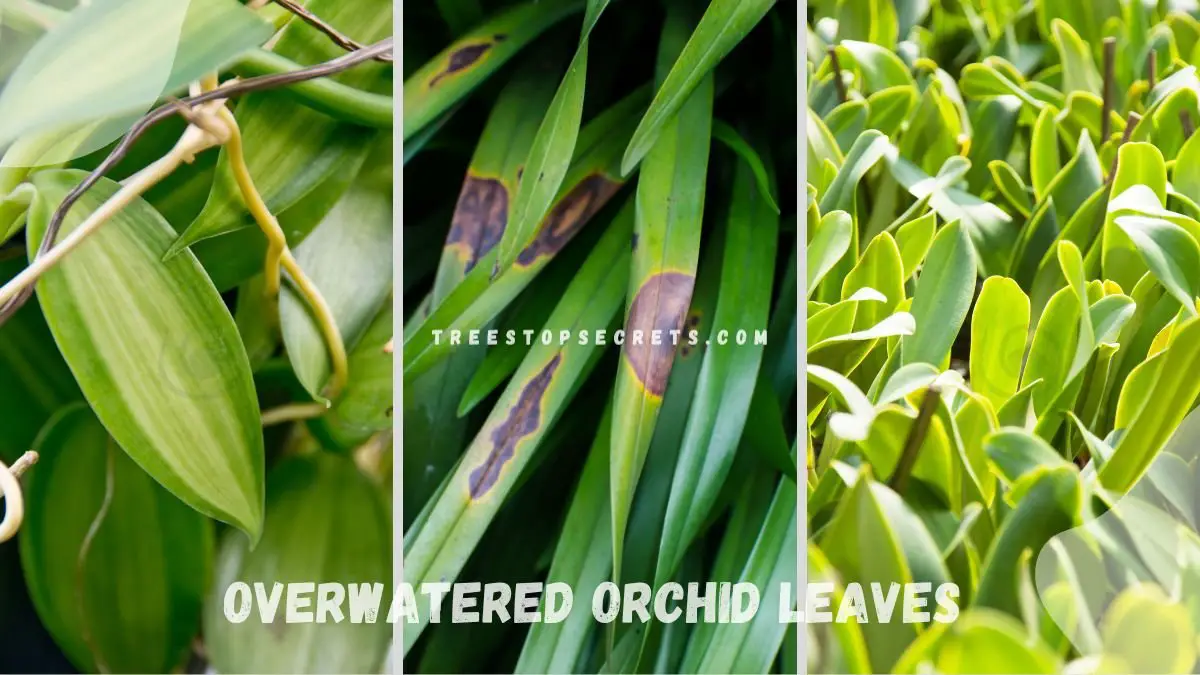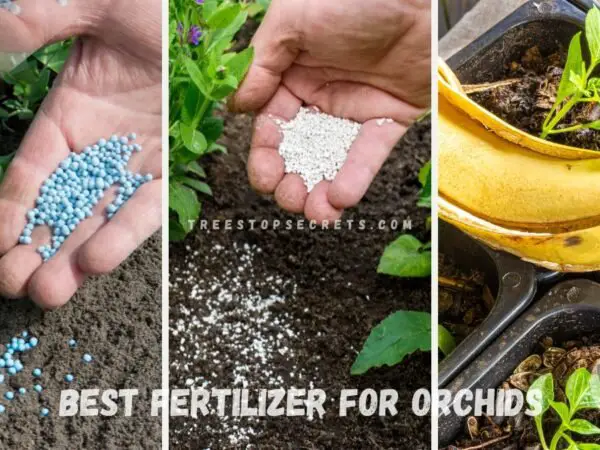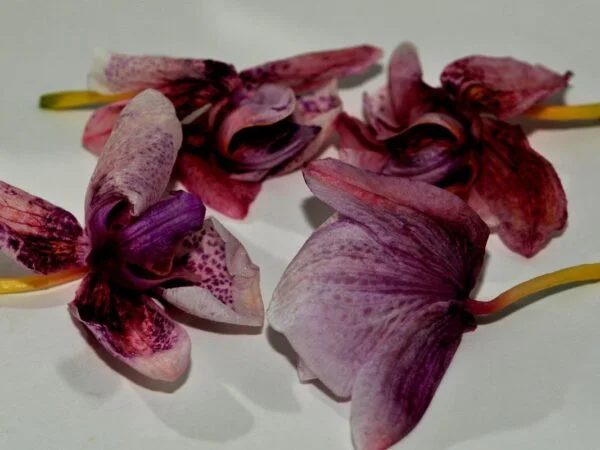Struggling with overwatered orchid leaves? You're not alone. Orchids are sensitive plants that can suffer significantly from excess water. If you’ve noticed yellowing, mushy, or drooping leaves on your orchid, overwatering might be the culprit. Proper diagnosis and corrective actions can revive your plant’s health. Let’s explore how to identify and treat overwatered orchid leaves to restore your orchid’s vitality and ensure it thrives.
Overwatered orchid leaves typically exhibit symptoms like yellowing, mushiness, and an overall droopy appearance. The roots of the orchid may appear brown or black instead of healthy green or white, often accompanied by a foul odor. This condition arises when the plant is given too much water, preventing oxygen from reaching the roots and leading to root rot. To remedy this, first remove the orchid from its pot, cut away any rotting roots, and allow the plant to dry out before repotting it in fresh, well-draining orchid mix. Ensure you water only when the top inch of the medium feels dry.
| Symptom | Description |
|---|---|
| Yellowing Leaves | Leaves turn yellow, often mushy. |
| Root Appearance | Brown/black roots, may smell foul. |
| General Look | Droopy, lifeless leaves. |
Interested in more orchid care tips? We've got additional advice to help your orchids flourish, from ideal watering schedules to the best potting practices.
Key Takeaways
- Recognize Overwatering: Watch for signs like yellowing leaves, mushy stems, or root rot to identify overwatering issues early.
- Address Overwatering: Adjust your watering schedule, ensure proper drainage, and repot if necessary to save your overwatered orchid.
- Use Keiki Paste: Apply keiki paste to encourage the growth of new offshoots and help your orchid recover from overwatering damage.
- Prevent Overwatering: Establish a consistent watering routine, use a well-draining potting mix, and monitor humidity levels to prevent future overwatering incidents.
- Orchid Care Essentials: Remember the importance of proper light, temperature, and air circulation in maintaining the health of your orchids.
Recognizing Overwatering
Signs of Trouble
Identify signs of trouble early to prevent further damage. Look for yellowing or browning leaves, as well as mushy or soft textures. Act promptly when you notice any abnormalities in your orchid leaves. Monitor your orchid regularly for any changes in leaf color or texture.
Unhealthy Leaf Indicators
Understand the different indicators of unhealthy orchid leaves. Differentiate between yellowing, dark green, white, limp, wrinkled, and purple/reddish leaves. Recognize the signs that your orchid leaves are not in optimal condition.
Common Questions
Address common concerns about orchid care and leaf health. Provide answers to frequently asked questions regarding orchid leaves. Help orchid enthusiasts troubleshoot issues related to their plant's leaves.
Addressing Overwatering
Orchid Rescue Steps
Rescue an orchid with leaf problems by adjusting watering frequency and drainage. Prune damaged leaves to promote new growth. Ensure proper light and humidity levels for recovery.
Implement strategies like repotting in fresh, well-draining medium to revive your orchid's health. Monitor soil moisture carefully to prevent overwatering. Adjust watering schedule based on plant needs.
Follow a systematic approach by inspecting roots for rot and trimming affected areas. Reevaluate watering practices to prevent future issues. Provide optimal care to encourage leaf regeneration.
Treating Root Rot
Promptly treat root rot by removing affected roots and repotting in fresh medium. Enhance drainage to prevent water accumulation. Avoid overwatering to maintain root health.
Address root rot issues by improving air circulation around roots. Consider using a fungicide if necessary, following instructions carefully. Monitor plant closely for signs of recovery or further deterioration.
Implement techniques like reducing watering frequency and ensuring proper ventilation to prevent root rot from spreading to leaves. Maintain a balanced watering routine to support root system health.
Yellow Leaves Fix
Fix yellowing orchid leaves by adjusting watering practices and light exposure. Trim yellowed leaves to redirect energy towards healthy growth. Maintain consistent care for optimal results.
Restore your orchid's leaves by providing appropriate nutrients through fertilization. Adjust water and environmental conditions to promote leaf health and prevent discoloration. Monitor progress regularly for improvements.
Take specific steps like checking for pests and diseases that may cause yellowing. Treat underlying issues promptly to prevent further leaf damage. Maintain a clean growing environment for overall plant health.
Fungicide Use
Use fungicides judiciously by selecting products safe for orchids and following dosage instructions. Apply fungicides at the first sign of fungal infection for effective treatment. Rotate between different types of fungicides for better control.
Understand the importance of timing when applying fungicides to combat leaf issues effectively. Consult with experts or local garden centers for recommendations on suitable fungicides. Always wear protective gear when handling chemicals.
Learn about the potential risks associated with fungicide use and follow safety precautions diligently. Avoid excessive application to prevent harm to plants and surrounding environment. Dispose of unused chemicals responsibly.
Using Keiki Paste
Propagation Techniques
Propagation techniques for orchids involve various methods to expand your plant collection and ensure healthy leaf growth. One effective technique is using Keiki Paste to promote the development of new orchid plants. By applying this paste to a node on the orchid stem, you can stimulate the growth of a keiki, which is a young plantlet.
To successfully propagate orchids using Keiki Paste, start by identifying a healthy node on the orchid stem where you want the keiki to grow. Apply a small amount of Keiki Paste to the node, ensuring it is in direct contact with the tissue. This paste contains growth hormones that encourage the formation of a new plant.
Another method involves using sphagnum moss to support the growth of the keiki after applying the paste. Wrap the node with damp sphagnum moss and secure it with a plastic wrap to create a humid environment ideal for root development. Regularly mist the moss to maintain moisture levels.
Benefits of Using Keiki Paste
- Promotes the growth of new orchid plants
- Contains growth hormones for enhanced development
- Facilitates successful propagation with minimal effort
Preventing Overwatering
Watering Tips
To master essential watering tips for orchids, ensure you water them only when the top inch of the potting mix is dry. Avoid overwatering to maintain healthy leaves.
Common watering mistakes like leaving orchids in standing water can lead to root rot and damage the foliage. Monitor your orchid's moisture needs regularly to prevent overwatering.
Repotting Guidance
Receive guidance on when and how to repot your orchid to promote leaf health. Understanding the importance of repotting helps maintain overall plant well-being.
When repotting, ensure you choose a suitable potting mix and container size for optimal growth. Follow step-by-step instructions to successfully repot your orchid without causing stress to the plant.
Root Rot Prevention
Implement preventive measures to avoid root rot in orchids, which can adversely affect leaf health. Protecting your orchid's roots is crucial for maintaining healthy leaves.
To prevent root rot, ensure proper drainage in the potting mix and avoid waterlogged conditions. By following best practices, you can safeguard your orchid's roots and preserve the quality of its leaves.
Orchid Care Essentials
Correct Watering
Master the art of watering your orchids correctly to maintain healthy orchid leaves. Understand that improper watering can lead to distress in orchids, especially affecting their leaves. Follow specific guidelines to water your orchid properly, ensuring it receives adequate moisture without being overwatered.
Ideal Temperature
Maintain the ideal temperature range to promote the health of your orchid leaves. Recognize the critical role temperature plays in orchid care, impacting the overall well-being of your plant. Ensure your orchid thrives by providing the right temperature conditions, preventing any stress on its leaves.
Sunlight Needs
Fulfill your orchid's sunlight requirements to support optimal leaf health and growth. Knowing the amount of sunlight your orchid needs is crucial to prevent any damage to its leaves. Strike a balance in providing sufficient sunlight to keep your orchid leaves vibrant and healthy throughout their growth cycle.
Nutrient Checks
Regularly check and ensure that your orchid receives essential nutrients for healthy orchid leaves. Understanding the significance of nutrients in maintaining your plant's leaf health is vital. Learn how to identify nutrient deficiencies promptly and address them effectively to prevent any issues with your orchid's leaves.
Final Remarks
You've learned how to spot overwatering signs, treat your orchid, use Keiki paste, and prevent overwatering for healthier plants. Remember, a well-cared-for orchid rewards you with vibrant blooms and lush foliage. By following these care tips, you ensure your orchid thrives and graces your space with its beauty.
Take action today by applying these techniques to your orchids. Your plants will thank you with their stunning display of colors and strong, healthy growth. Keep nurturing your orchids with the knowledge you've gained, and watch them flourish under your attentive care.
Frequently Asked Questions
FAQ
How can I recognize overwatering in my orchid plant?
Overwatering in orchids can be recognized by yellowing leaves, mushy stems, and root rot. If you notice these signs, it's crucial to adjust your watering routine promptly to prevent further damage to your orchid.
What are effective ways to address overwatering in orchids?
To address overwatering in orchids, allow the roots to dry out by reducing watering frequency. Repot the orchid if necessary, trim any affected roots, and ensure proper drainage in the pot to prevent future overwatering issues.
How can I use Keiki Paste to help my overwatered orchid recover?
Apply Keiki Paste to the nodes on the stem of your orchid to stimulate new growth and encourage the development of keikis (baby orchids). This can help rejuvenate an overwatered plant and promote healthy growth.
What are some tips for preventing overwatering in orchids?
To prevent overwatering in orchids, ensure proper drainage in the pot, use a well-draining potting mix, water only when the top layer of the potting medium is dry, and avoid leaving standing water in the saucer. Monitoring your plant's moisture needs is key to preventing overwatering.
What are the essential care practices for maintaining healthy orchids?
Essential orchid care practices include providing adequate light levels, proper watering techniques, maintaining appropriate humidity levels, fertilizing regularly but sparingly, repotting when necessary, and monitoring for pests and diseases. Consistent care and attention will help your orchids thrive.
Image Source: Paid image from CANVA




